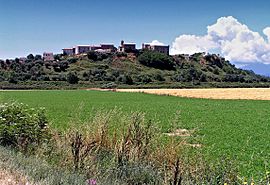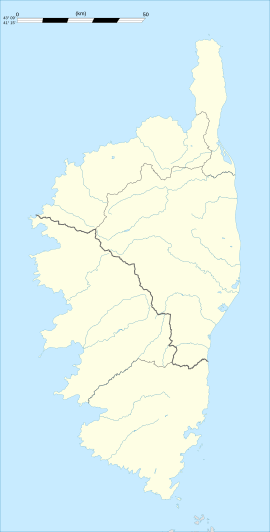Aléria facts for kids
Quick facts for kids
Aléria
Aleria (Corsican)
|
|
|---|---|

View of Aléria
|
|
| Country | France |
| Region | Corsica |
| Department | Haute-Corse |
| Arrondissement | Corte |
| Canton | Ghisonaccia |
| Intercommunality | Oriente |
| Area
1
|
58.33 km2 (22.52 sq mi) |
| Population
(2021)
|
2,211 |
| • Density | 37.905/km2 (98.174/sq mi) |
| Time zone | UTC+01:00 (CET) |
| • Summer (DST) | UTC+02:00 (CEST) |
| INSEE/Postal code |
2B009 /20270
|
| Elevation | 0–102 m (0–335 ft) (avg. 10 m or 33 ft) |
| 1 French Land Register data, which excludes lakes, ponds, glaciers > 1 km2 (0.386 sq mi or 247 acres) and river estuaries. | |
Aléria is a town located on the island of Corsica in France. It is known for its long history, dating back to ancient times. Aléria was once an important ancient Greek and Roman city. Today, it is a quiet commune (a type of local administrative area) and a significant archaeological site. It is also the easternmost point in mainland France.
Contents
Exploring Aléria's Location
Aléria is about 70 kilometers (43 miles) south of Bastia, a major city in Corsica. It sits in the middle of the Plaine Orientale, a flat coastal area facing Italy. Most of Corsica is very mountainous, so this flat plain is quite unique.
Coastal Features and Rivers
The eastern coast near Aléria has many lakes, called étangs by the Corsicans. These lakes are remnants of old lagoons, which are shallow bodies of water separated from the sea by sandbars. They sometimes connect to the Tyrrhenian Sea.
Historically, marshlands near the coast caused problems with Malaria. Today, the beautiful sandy beaches are popular for recreation. The Tavignano River flows through Aléria and into the Tyrrhenian Sea. Its lands include a delta (where the river spreads out) and marshes. To the north is the Étang de Diane, a large lake. To the west, the Étang de Terre Rosse is a lake and reservoir that helps water the plain for farming.
A Look at Aléria's Past Location
Corsica has been home to people since the Stone Age. The east coast was often settled by powerful groups from the Mediterranean Sea. These included the Greeks, Etruscans, and Romans. They often built their cities near an étang because it could be used as a harbor.
The ancient Greek city, called Alalíē, was located between the Étang de Diane and the Tavignano River. This spot allowed them to control the whole area, including the river's mouth. Today, part of this old site is covered by the village of Cateraggio.
Later, when the Etruscans took over, they settled further south. The modern village of Aléria is mainly an archaeological site where visitors can explore the ancient Roman town. Even further south was the Etruscan burial ground, or necropolis. The name "Aléria" comes from the Roman town built after the Etruscans were defeated.
The area around Aléria is quite large. It includes farmlands, the entire Étang de Diane, and the Plage de Padulone beach. Since 1975, laws have created the Casabianda-Aléria Nature Preserve. This large preserve protects the land between the Tavignanu River and the Étang d'Urbinu.
Aléria Through Time
Aléria has a rich history, with different groups settling and ruling the area over thousands of years.
Early Settlements (Before the Romans)
Around 566 BC, Greeks from a city called Phocaea founded a city named Alalíē on Corsica. Some historians believe this city was also called Calaris. Alalíē had a large, beautiful harbor, likely the Étang de Diane. The Greeks used it as a trading center, taking slaves, resin, wax, and honey from the native people.
The Greeks were very active in trade and caused trouble for the Etruscans and Carthaginians (from modern-day Tunisia). These two powers sent a large fleet of 120 ships to fight the Greeks. In the Battle of Alalia, the Greeks won, but it was a very costly victory. They lost many ships and could no longer defend themselves.
Because they were weakened, the Greeks left Alalíē. The Etruscans then took over the city and ruled the island until the Romans arrived.
Roman Rule and Decline
The Romans took control of Alalíē during the First Punic War in 259 BC. They destroyed the city and cleared the area of Carthaginians. Later, around 80 BC, the Romans rebuilt the city on a promontory (a piece of land sticking out into the sea) and named it Aleria.
Under the Roman Emperor Augustus, Aleria became very important. It was the capital of the Roman province of Corsica and Sardinia. Large Roman fleets were stationed in the Étang de Diane. The Etruscan language slowly disappeared, and the island began to speak Latin, which later developed into the Corsican language we know today.
However, in the later Roman Empire, the port and city began to decline. A terrible fire in 410 AD caused great damage, and in 465 AD, the city was attacked by the Vandals. After these events, Aleria became a small, unimportant village. The Tavignano and Tagnone rivers gradually buried parts of the city, and the area became marshy and unhealthy.
Medieval and Modern Times
In the 13th century, the Republic of Genoa became interested in Aleria. By this time, the Latin spoken in Corsica had changed into Corsu, the local language.
The modern commune of Aléria was officially created in 1824. However, it didn't truly begin to grow again until after 1945. After World War II, American forces helped get rid of malaria, making the area safer. In 1957, an organization called SOMIVAC was created to help bring farming back to the eastern plain. This effort was very successful.
Also, a major archaeological project began in 1955, uncovering many secrets of Aléria's past.
Religious History
Aléria was once an important religious center. There is evidence that Christianity came to Corsica in the late 6th century. For a long time, Aléria had its own bishop, who was a high-ranking church leader. However, in 1801, during the time of Napoleon, the diocese (the area a bishop oversees) of Aléria was closed. Its territory was added to the diocese of Ajaccio, which then covered all of Corsica.
Discovering Ancient Aléria
Hundreds of archaeological sites in Corsica show that people have lived on the island continuously since about 6500 BC. People in Corsica often traded with other communities around the Mediterranean Sea.
Even though no large cities existed before the first Greek colony, Aléria was likely populated. Archaeologists found an ancient rubbish pit near the Étang de Diane. This pit, called Terrina IV, showed that people lived there during the Middle Neolithic period (Stone Age). They raised cattle and pigs, unlike other parts of the island that mainly kept goats and sheep. Later, during the Chalcolithic period (Copper Age), people at the site made copper goods.
The visible ancient buildings at Aléria date back to the Iron Age. In 1955, archaeologists began excavating the site. By 1958, they had uncovered the forum (the main public square) of the Roman city of Aleria, which was first used in the 1st century BC.
A pre-Roman, Etruscan burial ground was found about 500 meters (1,640 feet) south of the Roman city. It contained over 200 tombs and was used mainly from the 6th to the 3rd centuries BC. The Etruscans stopped using it when the Romans built their city.
Excavations since 1955 have shown that Aléria had wide-ranging contacts in the 6th century BC. Pottery pieces found there came from places like Ionia, Phocaea, Rhodes, and Attica. The tombs in the Etruscan necropolis have revealed amazing treasures. These include beautiful artworks, jewels, weapons, metalware, and decorated pottery.
Many of the ancient items found in Aléria are displayed at the Musée Jérôme Carcopino in Fort Matra, located in the village of Aléria.
Population Trends
| Historical population | ||
|---|---|---|
| Year | Pop. | ±% p.a. |
| 1968 | 1,913 | — |
| 1975 | 2,885 | +6.04% |
| 1982 | 2,410 | −2.54% |
| 1990 | 2,022 | −2.17% |
| 1999 | 1,966 | −0.31% |
| 2007 | 2,007 | +0.26% |
| 2012 | 2,191 | +1.77% |
| 2017 | 2,162 | −0.27% |
| Source: INSEE | ||
Aléria's Economy Today
The Étang de Diane is a large lake, covering about 600 hectares (1,480 acres). On Fishermans' Island in the lake, there is a huge mound of oyster shells. These shells have been accumulating since Roman times, when salted oysters were sent to Rome. Today, a company successfully raises molluscs (like oysters and mussels) in the étang. In the commune, farmers commonly grow grapes and citrus fruits.
See Also
 In Spanish: Aléria para niños
In Spanish: Aléria para niños
- Battle of Alalia (530–535 BC)
- History of Corsica
- Mediæval Corsica
- Torra di Diana



